
I made the mistake of planting these wood-lot trees too close together.
|
Home Index |

|
|
Colourful new folliage on gum trees (photo about 2004). I made the mistake of planting these wood-lot trees too close together. |
The aim of this page is to allow readers to learn from my mistakes - and my successes. I have planted over a hundred fruit and nut trees, hundreds of olive trees, and thousands of native trees over the past thirteen years on the family patch at 'Elysium', Armagh, in the Clare Valley of South Australia.Also see Growing smaller plants in the Clare Valley.
There have been some disasters (of the first 80 Banksias planted, all died), many limited successes (olive trees, for example), and some good successes (several species of Eucalypts, acacias, quinces, citrus, figs, feijoas, mulberries, and some others thrive).
Hopefully I've learned something about what helps to keep trees alive, and what might make them thrive rather than just survive in the soil and climate conditions at Clare. If that can be passed on to some other people, perhaps their learning process will be a little quicker and easier than mine was.
Note that many of the statements made on this page apply to my experience in the Clare area and may not apply in different areas, in different soils, different climates or different micro-environments.
All the photos on this page were taken on Elysium.
|
On this page... Resources Culture Problems Fruit trees Nut trees Native trees Other trees Index |
Contact: Feedback welcome, email daveclarkecb@yahoo.com
|
PhilosophyStuardship, not ownershipFirst, I don't believe that we 'own' our land in the same way that we own a camera or a computer. We are stuards of the land. It has been said that we don't inheret the land from our parents, we borrow it from our children. Any landowner who has allowed his soil to be damaged substantially, or worse, to be washed or blown away, has failed in his primary responsibility. Any landowner who has left the soil in better condition than it was in when he took on the stuardship responsibility can be proud.
It's a lot easier to work with nature than against itI've learned that, with 46ha to try to manage, and with minimal machinery, it is important to work out what 'fits' with the land and climate, rather than trying to grow what is not well suited to the land. One tries to - in a way - impose one's will on the topp 20cm of soil; to stop it from growing plants that one doesn't want (weeds) and get it to grow plants that one can be satisfied with. The top 20cm of soil on 'my' property, I calculate, weighs about 160 million killograms. I weigh about 75kg. If I am to have any chance of 'controlling' two million times my own weight of soil, with little use of machinery, I must do things that the soil is well suited to doing. As has often been said, you have to work with nature, not against it. |
Classified by successI've kept this list simple.Mainly common names here. All referrences are on this page. Trees that thriveAcacia notabilisAcacia pycnantha Apple Carob Citrus Eucalypts Feijoa Fig Red gum Illawarra flame tree Loquat Macadamia Native pine Pecan Pinus radiata Quince Trees that do alrightApricotBanksias Bottlebrush Bunya pine Chestnut English oak Sugar gum Mulberry Nectarine Oak_silky Olives Peach Trees that need a lot of careAvocardoDisastersPersimmon |
The soil, its structure and its drainage can be improved by mounding and especially mulching. The soil can deeply crack as it dries in summer, with the risk of tunnel erosion. On the other hand, I think that this cracking can provide easy paths for plants to get their roots down to considerable depths.
|
Home Top Index |
Also see irrigation.
|
Home Top Index |
I've included in this section things that I do to help the trees
survive, to conserve the soil, etc.
IrrigationMy irrigation of trees is by dripper. I only irrigate around the home garden, all other trees make do with natural rainfall.I try to water most of my fruit and nut trees from the dam; the olive trees made do with well water when they were young, they have had no water in recent years. The salinity of the dam water varies between about 200-400 mg/L. Many fruit and nut trees get watered about every couple of weeks in summer. I'm sure many trees would do better if they received more water. Some trees, including oaks I've given some water during their first summer, and then they have to look after themselves. Generally the only water native trees get is a good soaking when they are planted. Our olive trees were given some water for only their first four years or so. Also see the entry on water under Trees: Resources. MoundingPlanting a tree on a mound improves the drainage; the steeper slopes that the mound creates helps excess water drain away. I have been using substantial mounds since about 1999; my impression is that they can, if large enough, solve the water-logging problem. Water logging is worse some winters than others; it was particularly bad in the relatively wet winter of 2001.MulchingOrganic mulching is very important in reducing evaporation and improving the structure, drainage, fertility and water-holding capacity of the soil.I do not bring gravel onto the property for use as mulch, but I have used slabs of rock to build retaining walls (see Cellar) and as a border to paths (see Stones for water conservation). In 2001 and 2002 I used grape mark as mulch (what is left after the wineries have finished with the grapes: skins, stems, etc.) because it could be had in the Clare Valley for the price of carting (in 18 tonne loads). In large quantities it is not suitable for use in towns because it is strong smelling for the first few months. I have found it to be quite acceptable: it is easy to handle, has no viable seeds in it, reduces evaporation from the soil and adds organic matter to the soil as it breaks down. Unfortunately grape mark was not available from 2003 onward, so I changed to sawdust (which was available from Morgan's sawmill at Jamestown for about $200 for 30m3 delivered). This seems to be very good; it is easy to shovel, light weight to cart, conserves soil moisture very effectively, and controls weed germination. Sawdust is water-repellent when dry and is slow to break down; this latter means that sawdust does not seem to cause nitrogen-drawdown. I have not been able to get sawdust from 2005 onward (when I 'phone Morgan's they say that they will organise it, but it has not actually happened). Recently I have had a couple of loads of tree-lopping mulch from Fox's. It seems to be quite acceptable, but is not so easy to handle as sawdust; nitrogen-drawdown is heavy for the first few months. Cereal straw, or better yet, legume straw is also good for mulching. Cereal straw can be difficult to get out of big round bales. |
Readers might have noticed that in the drier parts of Australia vegetation is often more luxuriant adjacent to roads. This is due to the fact that this vegetation effectively gets more rain than vegetation elsewhere. Roads, especially but not only sealed roads, do not absorb much rain water; it usually runs off. This is effectively a form of accidental irrigation. A similar effect can be achieved by using stones to line paths (and gravel as a base to a path). The rain runs off the stone and soaks into the nearby soil. Also, when the rain is over, the stone provides a barrier between the damp soil and the air; reducing evaporation losses. When using stones is this way one should consider that weeds will grow between the stones (control by hand weeding and spot spraying), and that the stones are heavy and hard work is involved in placing and moving them. |
Tree Guards
My standard tree guard is 1.05m wire netting wrapped around an old car tire as a base, and with a rough frame of either pine or gum sticks, wired to the tire and wired together at their ends, to protect the guard from crushing by sheep. This protects against hares as well as the sheep. Once the trees start to stick out the top of the guard, the sheep will reach over and eat them; one of several things can be done:
|
|
Home Top Index |
I wish I had a simple cure to offer for this problem, all I can suggest is:
This can be at least partly controlled by mounding and mulching.
Sheep are particularly destructive anywhere near the top of a hill where they like to camp. Unfortunately, tops of hills are good places to plant trees: to reduce the wind speed a bit and even to provide some shelter for the bloody sheep!
|
Home Top Index |

|
| I built this 81m2 bird exclusion area, based on 3m creosote poles and wire netting, in 2004 at a cost of about $900. |
They are a little slower to get stone fruit, harder on peaches and nectarines than apricots and plums; but still, we loose a lot. I suspect the only way to protect your fruit is to completely net the trees.
We have tried a plastic hawk tethered to a pole; didn't seem to have any effect at all. One trick we heard of recently was to spray the ripening fruit with Omomatic (clothes washing detergent), the birds supposedly will stop eating because they don't like the taste, while it is easily washed off before human consumption. Might be worth a try.
The only answer that I can guarantee is netting, as in the illustration at the right.
There is a mistletoe Action Group in Clare that, for a time helped pay for
lopping mistletoe from your trees. Contact the Council. (July 2002)
The cost of professional lopping of mistletoe from a large blue gum is
more than $100 per tree.
|
Home Top Index |
In alphabetical order of botanical names
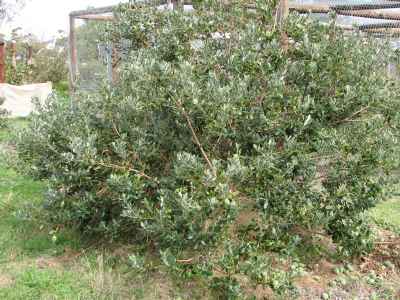
|
| Photo May 2007 - This tree was planted about 1996 |
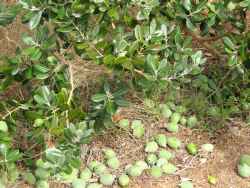
|
| Some of the very heavy crop of 2007 |
The fruit are tasty, slightly astringent, (no pealing needed, no stone or large seeds to spit out), and the birds haven't recognized that they are edible.
We planted a second tree about 2000 and it produced its first crop in 2003. Unfortunately the fruit from this tree is not so nice as that from the first, although they do improve when allowed to become very ripe. This tree is apparently a different variety to the first.
Feijoas do better at Clare if they get an occasional deep watering through the summer.
I have not mounded these trees, they don't seem to need it.
See also the true
Guava.

|
| Planted about 2002, photographed 2005/03/10 |
They produced a very few cherries for the first time in the
summer of 2005. In 2006 we had a 5L bucket of cherries from each tree.

|
| May 2007 - The foliage is a healthy dark green, I've found it very difficult to get such healthy foliage on citrus trees in another area. |
The Citrus trees have been mounded, although I've seen no evidence that they suffered from water-logging. We were warned to not plant Citrus until about September to reduce the risk from frosts. We did this, and have never seen any indication of frost damage.
|
Home Top Index |

|
| January 2002. This tree has produced a couple of useful crops, and it looks like there is another on the way. Ready to pick in March? |
Quinces are attacked by birds, but not to the same extent as are stone fruit or apples. Another advantage of quinces is that since they are usually grown on their own roots they can be propagated from suckers.
Quinces cannot be eaten fresh, but are good stewed and make a delicious
clear quince jelly that can be used like jam.
Loquat: Eriobotrya japonicaWe planted two trees grown from suckers about 1996. They are close to our septic tank outflow and are doing very well. They have not been mounded.We removed these trees in 2005 because, while they remained healthy, they did not produce a useful crop. |
|

|
| This tree has produced several good crops in spite of not getting a lot of water or other attention. January 2002. |
They are easily propagated from cuttings or suckers, but do not like their roots disturbed when planting. In future I will pot any that have bare roots so that I can give them close attention and plenty of water, and only plant them out - with care to not disturb the roots - when established in the pot.
Mounding does not seem to be necessary, the trees have shown no
signs of suffering ill-effects from water-logging.

|
| The wire-netting is the type commonly used for farm fencing. It protected the apples from birds; we picked a big crop in February 2002. |
|
Home Top Index |
It seems that fully covering apple trees with netting is the only way to protect them from birds.
Apples and pears seem to do fairly well even without water in addition to
natural rainfall.
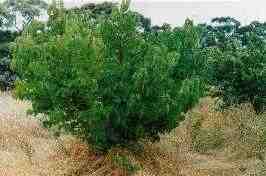
|
| This mulberry tree is growing well. Photo January 2002 |
I have planted several more since these first two, but they are not yet
(April 2007) old enough to produce a crop.

|
|
Having a tea break during olive picking. A fair part of Elysium is visible in the background. |
My impression is that they don't like the water-logging that happens almost every winter, and that they need more water than I am prepared to give them if they are to set a commercial crop in the spring. They seem to suffer from the fairly quick change from wet feet to hard, dry soil in spring; especially as this often coincides with their flowering.
Still, if you only want some olives to pickle and some oil to use yourself and to give away to friends, then, by all means, plant some olive trees.
The SA Verdale variety seem to produce the largest crops while not
getting any irrigation. Manzanillo is another good cropper, but it
has a reputation for being difficult to extract the oil from the olive pulp.
Avocado: Persea americanaWe planted the first two avacado trees about 1996. They did well for a year or so, then died. I believe that the problem was to do with water-logging in winter and hard, dry soil in summer. Mounding will help avoid water-logging and mulching will conserve moisture and eventually improve the soil.We planted another avocardo in 2005 and early in 2007 it has produced a few fruit and is still doing well. It has been kept heavily mulched, has been mounded, and watered fairly regularly through summer. I'd say that if you want to grow avocardos in the Clare area, they will need a place that does not get heavy frosts, low salinity water in summer, and protection from water-logging in winter. |
|
 January 2002 - This Moorpark tree was planted in winter of 2000.
It and five others nearby are doing well. Note the weld-mesh
tree guards; these are the next stage
after trees outgrow the simple, cheap, wire-netting
guards. Also
note the
mounds and
mulching.
January 2002 - This Moorpark tree was planted in winter of 2000.
It and five others nearby are doing well. Note the weld-mesh
tree guards; these are the next stage
after trees outgrow the simple, cheap, wire-netting
guards. Also
note the
mounds and
mulching.
|
We planted another six trees in the winter of 2000, this time on mounds. They are producing good crops and, in early 2007, are still looking healthy.
Sheep find apricot leaves, and even bark, very palatable.
|
Home Top Index |

|
| Two plum trees in January 2002 |
We planted about ten trees in 1994. These produced quite a heavy crop once in a while. Most of these have not been watered in recent years and seem rarely to produce a significant crop. A couple of satsumas that were planted where they can be conveniently watered through summer are producing much larger and more reliable crops.
It seems that while plum trees grow like weeds in the Clare Valley, in order
to get a crop from the better breads, they will need additional water
through the growing season.
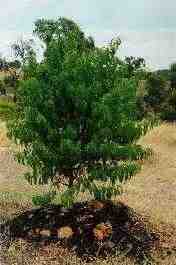
|
| A peach tree at Elysium, in its second year of growth; January 2002 |
The tree in the photo on the right is still doing well in 2007.

|
|
Photo Jan. 2007. It is about 1m high. |
The fruit are small, extremely rich in vitamin C, and have a strawberry-like flavour. They can be eaten fresh, or made into jams and jellies.
Also see Feijoa,
which are alternatively known as pinapple guava.
Several were planted in a large bird-excluding enclosure in 2004.
By 2007 they had produced some fruit.
|
Home Top Index |
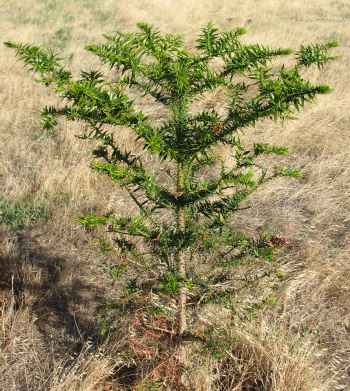
|
|
Photo Jan. 2007 |
Bunyas, which are related to the famous and extremely rare walami pines,
can grow to very big trees in South Australia.
They are one of the very few trees that I have come across that
are entirely unpalatable to sheep.
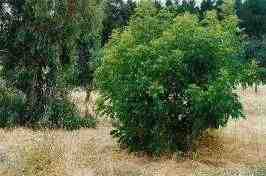
|
|
Photo January 2002. In Jan. 2007 this tree is about 4m tall. |
The red gum in the background of the photo,
planted about the same time as the pecan, was removed in early 2003.

|
|
Photo Jan. 2007 |
|
Home Top Index |
The second one, planted in the winter of 2002, did show some salt burning in 2003, probably because it was irrigated with bore water at around 1100mg/L through the summer.
In early 2007 this tree is doing very well and has produced some nuts.
One other, dug out in about February 2007, is still surviving in late
April 2007.
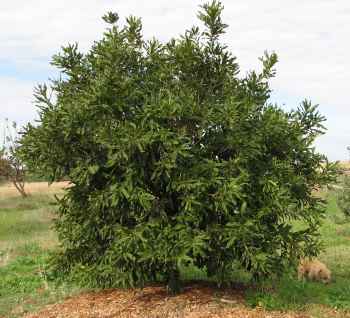
|
| A macadamia tree, photographed May 2007 |
We planted three more in 2006. As of early 2007 the four surviving older
trees are still producing many nuts. My impression is that the trees need
a fair bit of water if they are to grow large nuts.
 |
 |
| Two pistachios, January 2002 - the tree on the right should have been pruned when dormant in winter. | Photo Jan. 2007 |
As of May 2003 the pistacios were still doing well, but not yet producing.
|
Home Top Index |
Through years of trial and error at Elysium
I have come to the conclusion that the
best way of planting those native species that are easy to grow at
Clare is as follows (this technique has been developed for broad-acre
planting of many trees with minimum expense and effort but without
special machinery):
|
More distant is a plantation of mainly Eucalypts, some Allocasuarina. (I planted these trees too close together. My current thinking [2007] is to plant big wood-lot species no closer together than 10m.) This is the same patch of trees as shown on the first photo at the top of this page.
Beyond the Eucalypts and Casuarinas the paler trees are olives.
The big trees are blue gums, probably fifty or more years old.
The photo was taken about November 2000.

|
| This Acacia notabilis was grown from seed and planted, together with many more, on a nature strip on Elysium adjacent to the Blyth road. |
|
Home Top Index |
While many have short lives, a decade or less, others can live many years.
They are easy to grow from seeds, although once I had a whole box of about fifty seedlings that failed to do well; just sat and felt sorry for themselves.
Seedling come up uninvited, apparently being brought in by birds; all
they need to grow then is protection from the
sheep.
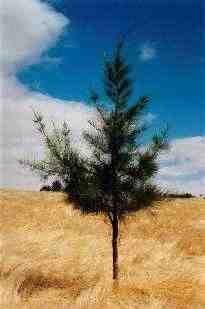
|
| Planted about 1994, photographed 2002 |
This tree grows quite well at Elysium, although certainly more slowly than the Eucalypts.
An alternative name is Casuarina stricta.
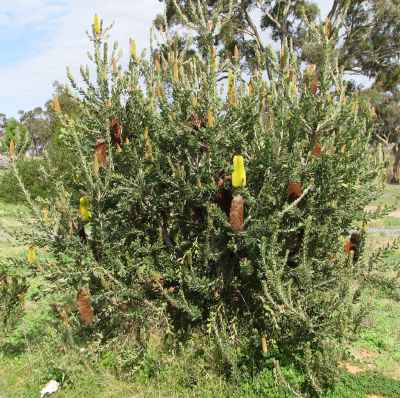
|
| This tree was planted about 2002 and the photograph taken in May 2007. |

|
| A blossom on the same tree |
Yet Ian Roberts, at Banksia Park, which is within easy cycling distance, grows them quite successfully. I can only ascribe my problem to lack of good soil drainage; they couldn't stand the winter water-logging.
In more recent times I have planted several Banksias in small heaps of sand and most of these have done quite well.
|
Home Top Index |
Illawara Flame Tree: Brachychiton acerifoliusNot fast growing, but neither are they at all difficult to grow; Several of these have been sucessfull at Elysium. They have not been given any special attention. |

|

|
|
The lower part of these trees have been defoliated by sheep. |
|
Home Top Index |
Callitris are also very slow growing, however they are beautiful trees and are worth waiting for. One of my favourites of the local natives.
It's possible these are C. preisii rather than C. collumnaris.
Callitris will self-seed.
There are over 700 species, most of them endemic to Australia. Depending on their type of bark and their growth habit Eucalypt species are often placed in groups such as box trees, mallees, stringybarks and ironbarks.
Gum trees were, with the Australian landscape, the main subject of the great Australian painter Hans Heysen. Most often he painted red gums.
The section on Planting native trees applies especially to Eucalypts.
A pest of Eucalypts is
lurps.
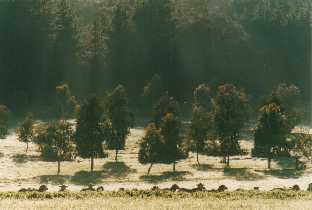
|
| The young trees in the photo are red gums that were planted about 1994. This gully becomes very wet every winter; the red gums are plainly thriving. Pinus radiata in the background. |
A truly remarkable tree; very tolerant of water-logging, easy to grow and quick growing, not bothered much by frosts, and drought tolerant. The only place I've found where they don't do well at Elysium is where they have some shade and root competition from established Pinus radiata and blue gums.
Red gums are suitable for the production of
firewood in the Clare Valley.

|
Sugar gum: Eucalyptus cladocalyxA little harder to grow at Elysium than red gums and Tasmanian blue gums, but a very attractive tree when mature, and worth the little extra effort. They grow very well once established.Sugar gums are probably suitable for the production of firewood in the Clare Valley. |

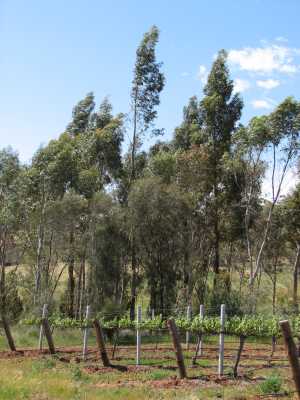
|
| The tallest trees in this photo are Tasmanian blue gums. |
Tasmanian blue gums are suitable for the production of
firewood
in the Clare Valley and would have to be about the best tree for the
production of polls because of their tendency to not fork and go straight
up.
| The tree in the centre of this photo is a Tasmanian blue gum. |

|
| There were about fifty large SA blue gums on Elysium when we bought the property. Here are two of them on a misty winter morning in 2000. |

|
| These blue gums are self-sown. All have grown from seeds dropped by one large old tree. January 2002. |
SA blue gums are suitable for the production of
firewood
in the Clare Valley.

|
Home Top Index |
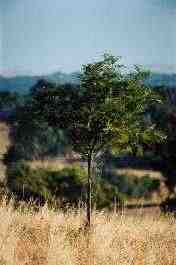
|
Silky oak: Grevillea robustaWe planted perhaps forty of these around 1995; I'd guess that 1/2 are still living. Some were killed by sheep who find the bark very apatising, some died from some other cause; perhaps they needed more watering in their first summer. |

|

|
| Three Melaleuca lanceolata on the nature strip beside the Blyth road at Elysium; photographed January 2002. These were planted about 1994. |
They are an attractive tree. The blossoms are not spectacular.
I suspect that a part of the reason they were planted was to try to lower the water table. They seem to have achieved this. They would probably not be suitable where shallow groundwater was more saline.
Our pine plantation should be thinned out. I tried to get a commercial timber business interested in doing the thinning in return for the logs, which would have been suited for treating as posts, but found that no-one was interested. I can't imagine that growing radiata would be a viable economic proposition in the Clare Valley, unless it was done over a very large area, say 300ha or more.
They can be cut for use as poles, but if they are in contact with the
soil they will quickly rot.
If not in contact with the soil, but exposed to the weather, I have found
pine wood can last anything from one year to about six years - depending,
it seems, on whether it becomes infected by the dry-rot fungus early or
later.
Painting with creosote seems to give them some protection, probably stopping
the fungal spores from getting started.
The wood can be used as firewood, but
tends to be corrosive if burned in an iron or steel stove; OK for
bonfires.

Three more were planted in the winter of 2001; two are still going in mid 2003.
They were put on low mounds, in or near a small gully, but they would suffer some root competition from adult gum trees that are only twenty metres or so from one of them.
|
Home Top |
Section headings...
Introduction
Resources
Culture
Problems
Fruit trees
Nut trees
Native trees
Other trees
General index...
Acacia
Acacia callamifolia
Acacia notabilis
Acacia pendula
Acacia pycnantha
Allocasuarina
Apple trees
Apricot trees
Avocardo trees
Banksias
Birds
Bottlebrush trees
Brachychiton acerifolius
Bunya pine trees
Callistemon
Callitris columellaris
Carob
Casuarina stricta
Ceratonia siliqua
Cherry trees
Chestnut trees
Citrus trees
Culture
English oak
Eucalypt trees
Eucalyptus camaldulensis
Eucalyptus cladocalyx
Eucalyptus globulus
Eucalyptus leucoxcylon
Eucalyptus maculata
Feijoa trees
Ficus carica
Fig trees
Firewood
Flame tree
Frost
Fruit trees
Grape mark
Grapefruit
Grevillea
Guava trees
Gum trees
Introduction
Irrigation
Loquat trees
Lurps
Macadamia
Melaleuca
Melaleuca lanceolata
Mistletoe
Mounding
Mulberry trees, black
Mulberry trees, white
Mulching
Native pine
Native trees
Nut trees
Oak_silky
Olea europaea
Olive trees
Other trees
Palatability
Paper bark tree
Peach trees
Pear trees
Pecan trees
Persea americana
Persimmon trees
Philosophy
Pine_Monterey
Pinus radiata
Pistachio trees
Planting native trees
Plum trees
Problems
Prunus armeniaca
Quercus robur
Quince trees
Red gum
Resources
Root competition
Sheep
Sheoak
South Australian blue gum
Spotted gum
Stones for water conservation
Sugar gum
Tasmanian blue gum
Tea-tree
Tea-tree_black
Top
Tree guard
Tree guard, mesh
Tunnel erosion
Walnut trees
Water
Water-logging
Wattle
Wattle, golden
Wattle, notable
|
Home Top |